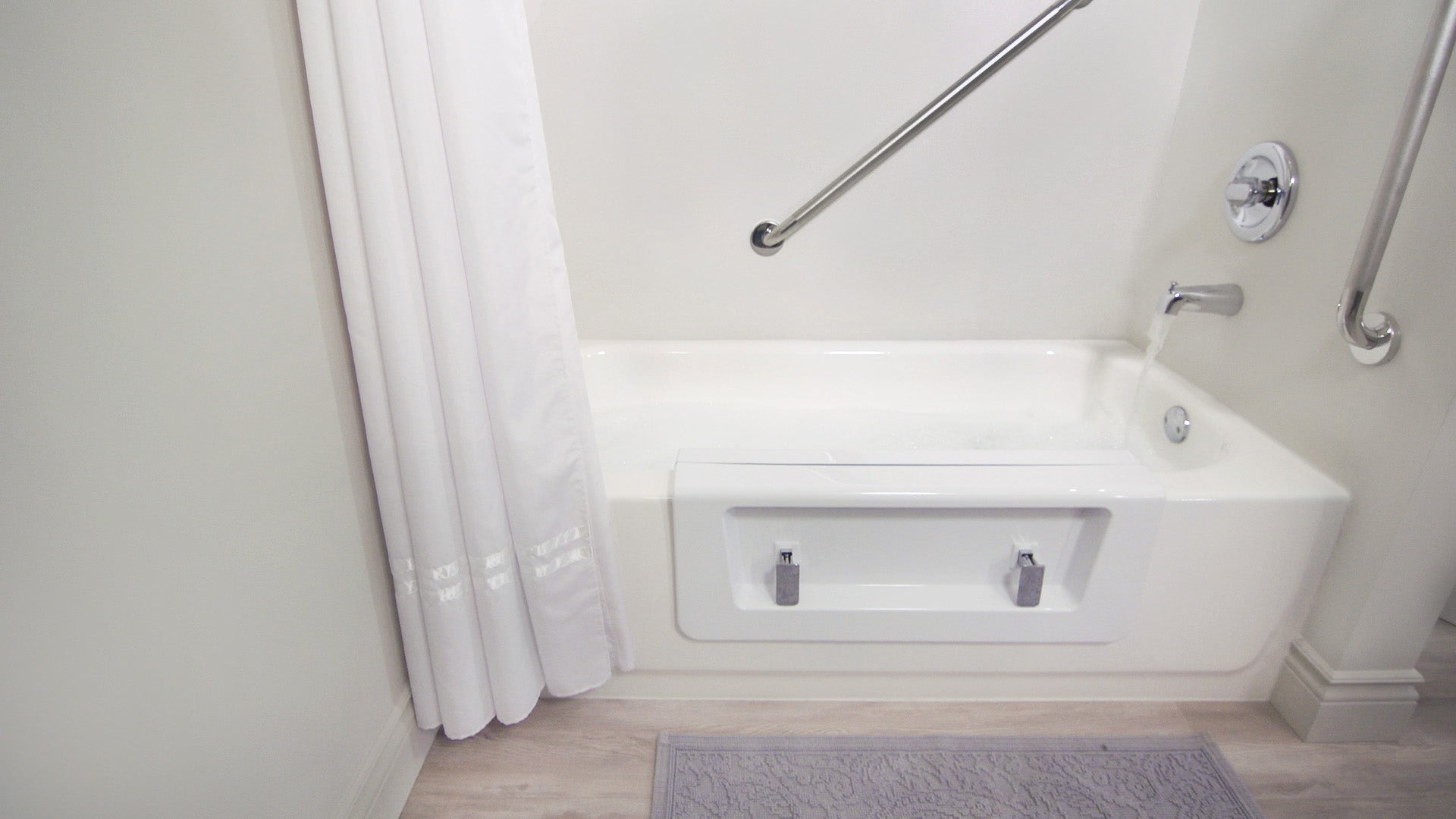Let’s be honest: bathrooms can be slippery, and nobody wants to feel nervous every time they step into the tub or shower. That’s why grab bars matter so much, and this is especially true for seniors or anyone with limited mobility.
More and more folks are searching for ways to age in place, and bathtub grab bars are a big part of that. And it makes sense, a well-placed, sturdy grab bar can mean the difference between feeling unsure on your feet and moving around with confidence.
In this post, we’ll walk through what actually makes a good grab bar, so you know what to look for before you install one in your shower, tub, or anywhere you need a little extra support.
Safety First: Why Grab Bars Matter
It might surprise you, but bathrooms are actually one of the places people slip and fall the most. This is especially true for older adults. According to the CDC, millions of seniors end up in the ER every year because of falls, and a lot of those happen near the tub or shower. That’s why grab bars for seniors can make a real difference.
A durable and sturdy bathtub grab bar or a few well-placed bathroom grab bars for elderly folks don’t just help prevent falls. They also give people the confidence to keep their independence longer. Instead of worrying about losing balance on a wet floor, you can focus on enjoying a warm shower or a relaxing bath.

Types of Grab Bars to Know
Not all grab bars are the same, though, and what works best really depends on where you need extra support. Let’s start with the basics: a bathtub grab bar usually clamps right onto the side of the tub. It’s great if you mostly need help stepping in and out, and installation is pretty quick. These types of bars should only be considered as temporary solutions. They are hand-tightened and, due to angled side walls of most bathtubs, they can come loose over time, and you won’t often realize that until it’s too late.
Then there are shower suction grab bars. These stick to smooth tile or glass and can be moved around easily. However, these are terrible. They don’t hold as much weight and can sometimes lose suction, which can cause even worse falls. So, it’s better to avoid shower suction cup grab bars. These should only be considered for use when traveling, and the suction aspect should be tested each time it is used.
When it comes to the very best shower grab bars, sturdy, wall-mounted ones are hard to beat. They’re installed directly into the studs behind your wall, or into wood blocking that has been added, so they’re strong enough to handle real loads when you need it most. There are also specific hollow wall fasteners that have been specifically designed for grab bars. One brand is made by WingIts and the other by Moen. If safety and long-term peace of mind are your top priorities, this type is usually the smartest pick.
Understanding ADA Standards
If you’ve been shopping around, you’ve probably come across terms like ADA-compliant requirements and ADA grab bars. But what does that really mean? In simple terms, ADA (Americans with Disabilities Act) standards are there to help make bathrooms and your environment safer and more accessible for everyone, especially folks with limited mobility.
For grab bars, the ADA recommends certain things like bar diameter, weight capacity, and placement. For example, most ADA shower grab bars should be mounted horizontally between 33 and 36 inches from the floor to make them easy to reach. They should also be able to support at least 250 pounds.
Placement & Height: Getting It Right

Where you put your grab bars matters just as much as which ones you buy. For starters, think about the shower grab bar height. As we mentioned, most experts (and the ADA) suggest mounting them about 33 to 36 inches from the shower floor so they’re easy to grip without stretching or bending too far.
Tub grab bar placement is just as important. A horizontal bar along the back wall helps with balance while standing, and a vertical bar near the entrance makes it easier to step in and out safely. A horizontal bar can also be placed at a bit of an angle, especially if being used in conjunction with a bench or seat. An angled bar allows you to help pull yourself up as opposed to just using your arm strength to get up. When it comes to grab bars for shower installation or installing grab bars in shower walls, it’s worth taking the time (or hiring a pro) to make sure they’re anchored securely into the wall.
Following these simple guidelines means your grab bars will actually do what they’re supposed to: keep you steady, supported, and confident every time you bathe or shower.
What to Look for in Quality Grab Bars
It pays to know what to look for before you buy. First, think about the material and finish. Look for grab bars that are rust-resistant and have a non-slip texture so your hand won’t slide, even when the bar is wet. Stainless steel or composite grab bars are best. Avoid chrome-plated grab bars as the chrome can eventually rust through and spall; the thin layer of chrome can be like having a razor blade attached to the bar. There are also many new styles of ADA-approved grab bars that are stylish and no longer look “institutional”.
Next up: length and weight capacity. Longer bars (like 24 or 36 inches) can offer support along more of the wall, while shorter bars should be used primarily when there is not enough space for a longer bar. And make sure your bar is rated to hold at least 250 pounds because that’s the standard for most quality models.
Grab bars that meet the ADA standard are 1 ¼” or 1 ½” in diameter. Avoid grab bars that are only 1” in diameter, as smaller bars are more difficult to hold on to. It’s also best to get grab bars that have snap-fit covers over the mounting plates and screws. This helps to limit water migration into the wall; using a double-sided adhesive disc under the mount plates also helps to stop water from getting behind the wall, as well as offering additional anchoring to the wall.
You’ll also want to think about installation. Some grab bars are easier to install yourself, but wall-mounted options that anchor using specialized fasteners often need a professional to make sure they’re really secure. Lastly, don’t forget about looks. A sleek finish or modern design can blend right in with your bathroom. So, you get safety and style at the same time.
You might also want to consider changing your towel bar for a grab bar that incorporates a towel rod. Conventional towel bars are not designed for slip and fall protection or to support any weight; switching your towel bars for a grab bar / towel rod combination can add a measure of safety outside of the tub or shower. They come in many styles and can be a stylish addition to your bathroom.
Pairing Grab Bars with Extra Safety
Adding the right grab bars is a great first step, but why stop there? If stepping over the tall side of the tub still feels risky, pairing those bathtub grab bars or grab bars for seniors with a Quick Tub Walk-Thru Insert can make an even bigger difference.
A Quick Tub insert creates a lower, safer entry point, so you don’t have to lift your leg as high to get in or out. When combined with sturdy, well-placed ADA shower grab bars, it turns your tub into a space that’s not only easier to use but genuinely safer day to day.
Together, these upgrades help take the stress out of bathing, giving you or your loved ones more confidence and independence in the bathroom.
At the end of the day, choosing the right bathroom grab bars for elderly family members (or anyone who wants to stay steady on their feet) is about finding the right fit, thinking through details like shower grab bar height, and making sure it’s sturdy enough to really do its job.
And if you really want to make your bathroom safer, pairing your new ADA grab bars with a Quick Tub Walk-Thru insert can go a long way. Together, they can help turn your bath or shower into a space that feels secure, comfortable, and easy to use every single day.
Ready to take the next step? Explore the Quick Tub Walk-Thru insert and see how it can work with your grab bars for a safer, simpler bathing experience.
FAQ Section
How to choose a grab bar?
Choosing a grab bar mostly involves selecting the correct length and size to ensure optimal functionality and effectiveness. Begin by assessing the dimensions of your bathroom and identifying the specific areas where you require support. The chosen grab bar must be long enough to provide the necessary assistance while fitting comfortably and safely within the available space.
How to choose the right grab bar length?
Choosing the right grab bar length depends primarily on the available space within your shower area and your personal requirements. Begin by measuring the width of your shower walls to ensure the grab bar will fit optimally. Additionally, consider your hand size, as the bar should be easy and secure to grasp for effective support. Prioritizing both spatial fit and personal comfort ensures you select the ideal length.
How high should grab bars be for the elderly?
Grab bars for the elderly should be mounted between 33 to 36 inches (840 to 915 mm) above the finished floor. This specific height range ensures the bars are within easy and safe reach for both seated and standing users.
Are suction grab bars better than regular grab bars?
No, wall-mounted grab bars are definitively superior for safety and reliable support compared to suction grab bars. Wall-mounted options provide significantly higher weight capacity and permanent, secure installation, making them the better choice for dependable, long-term stability.
Should grab bars be angled or straight?
Grab bars can be effectively installed either angled or straight, with the optimal choice depending on their intended use. Angled grab bars are typically recommended when the user needs to grip and pull themselves up, such as when exiting a bathtub or shower. Straight grab bars are best suited for steadying oneself while maneuvering, providing support to prevent falls, and reducing slips in areas like near a toilet or along a wall.



Share:
A Caregiver’s Guide to Making the Home Safer for Loved Ones
The Truth About Raised Toilet Seats: Benefits and Hidden Risks